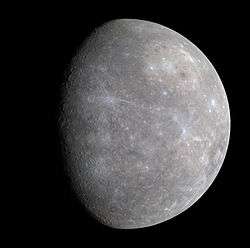Gibran (crater)
|
Arrow indicates pit crater within Gibran | |
| Planet | Mercury |
|---|---|
| Coordinates | 35°30′N 110°24′W / 35.5°N 110.4°WCoordinates: 35°30′N 110°24′W / 35.5°N 110.4°W |
| Diameter | 102.0 km[1] |
| Eponym | Khalil Gibran[2] |
Gibran is a crater on Mercury, which was discovered in January 2008 during the first flyby of the planet by MESSENGER spacecraft. It contains a large (29 × 29 km), nearly circular pit crater.[1] Multiple examples of pit craters have been observed on Mercury on the floors of impact craters, leading to the name pit-floor craters for the impact structures that host these features. Unlike impact craters, pit craters are rimless, often irregularly shaped, steep-sided, and often display no associated ejecta or lava flows.[1] These pit craters are thought to be evidence of shallow volcanic activity and may have formed when retreating magma caused an unsupported area of the surface to collapse, creating a pit. They are analogs of Earth's volcanic calderas.[1] Pit-floor craters may provide an indication of internal igneous processes where other evidence of volcanic processes is absent or ambiguous. The discovery of multiple pit-floor craters augments evidence that volcanic activity has been a widespread process in the geologic evolution of Mercury's crust.[3]
References
- 1 2 3 4 Gillis-Davis, Jeffrey J.; Blewett, David T.; Gaskell, Robert W.; Denevi, Brett W.; Robinson, Mark S.; Strom, Robert G.; Solomon, Sean C.; Sprague, Ann L. (2009). "Pit-floor craters on Mercury: Evidence of near-surface igneous activity". Earth and Planetary Science Letters. 285 (3-4): 243–250. Bibcode:2009E&PSL.285..243G. doi:10.1016/j.epsl.2009.05.023. See unnamed feature 2.
- ↑ "Mercury: Gibran". USGS. Retrieved November 20, 2009.
- ↑ "Picture of a Pit-Floor Crater". JHU/APL. July 21, 2009. Retrieved November 20, 2009.

